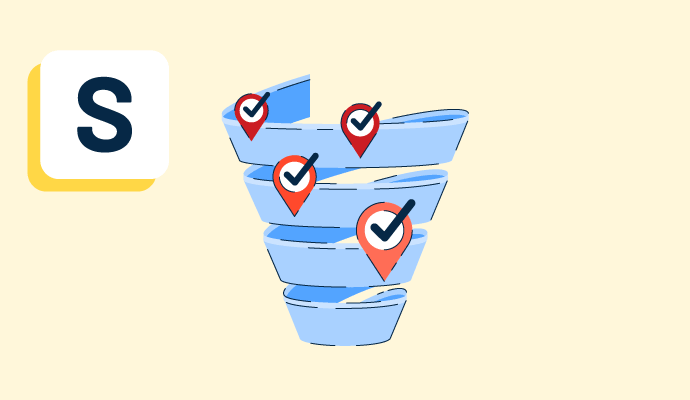What is sales enablement?
Sales enablement is how a company trains its sales representatives. It encompasses providing your sales team with the resources, guidance, and training needed to close more deals.
Even the best sales reps can improve their methods for winning over prospects. Every rep benefits from the right support and structure established through sales enablement.
Businesses often turn to sales enablement software to provide a repository of marketing resources and sales playbooks to supply representatives with productive, useful content during all stages of the sales cycle. These tools make it easy for representatives to find the necessary content, share it with prospects, and track engagement toward closing deals.
Armed with these resources and training, sales teams become more prepared during calls and presentations.
Basic elements of a sales enablement strategy
A successful sales enablement strategy should have the following basic elements.
- Reporting and analysis: A constant stream of information can overwhelm sales representatives and make it more difficult to close deals. Sales reports should be standardized based on activities logged by sales representatives, the number of demos delivered, deals won and lost, and leads generated. These reports make it easier to qualify leads.
- Sales content: Personalized seller content guides leads throughout the buyer’s journey. This content can include demo decks, case studies, and pricing information. Case studies are vital with regard to sharing the stories of customer success. Creating templates for email automation for sales representatives to send to leads also increases productivity.
- Technology and automation: Certain elements of the sales enablement process can be automated, like follow-up email sequences that trigger if a prospect hasn’t responded within a specific amount of time. Automated prospecting emails with a direct link to the rep’s calendar to schedule a demo can also be automated.
- Sales enablement software: No matter how big or small a sales team is, sales enablement software should always be in use. Customer relationship management (CRM) software, sales performance management software, and email tracking software all come in handy.
Benefits of sales enablement
Sales enablement gives teams a competitive advantage and more expertise toward closing deals. Some other benefits of sales enablement are:
- Increased revenue. When companies enact a sales enablement process, they’re often more successful in reaching sales quotas, leading to a boost in revenue for the organization.
- More productivity. The right sales enablement tools provide sales teams with a bump in productivity by simplifying the ways representatives find helpful content in real-time that will enhance outreach efforts and conversations with prospects. From better follow-up messages to more thorough presentations and demos, sales enablement helps send prospects through the sales pipeline.
- Consistent messaging. Having up-to-date sales content with consistent messaging can significantly affect how sales representatives interact with prospects and customers. When companies change or alter messaging based on competitive positioning or how the buyer's needs are changing, representatives will be on the same page regarding how to pivot conversations and leverage the right types of content for sales opportunities.
- Decreased turnover. When sales reps feel supported with effective resources and training, they are less likely to feel underappreciated and undervalued and less likely to look for positions elsewhere.
- Faster deals. With more training, resources, and support, sales representatives have access to everything they need to have better conversations with leads, which ultimately leads to closing deals faster.
- Stronger sales data. By utilizing sales enablement software, companies can collect and organize better data regarding their sales team. This data can include insights regarding buyer preferences, customer pain points, and buyer personas. This data can give sales reps information on how to tailor their sales approach.
- Improved alignment with marketing. A sales rep will likely have more success if they can provide prospects and leads with the right marketing materials at the right time. This can be done when sales and marketing teams collaborate with one another and have an efficient working relationship.
Sales enablement best practices
When implementing sales enablement within a sales team, there are specific best practices to follow.
- Utilize a CRM: CRM software can be beneficial in the sales enablement process. It should be used to give visibility to data to see how reps are performing, if milestones and quotas are being hit, and know more about how their behaviors impact goals.
- Define clear objectives: Sales enablement provides sales representatives with everything necessary to convert buyers, but it should also include clear objectives on what to focus on. This could be information about products, sharing best practices from top performers on the team, or tips on developing the best presentations. Teams can focus on other objectives, like ramp time, win rate, and deal size.
- Create a library of training material. Successful sales enablement starts with great content marketing resources that provide helpful information. This library of training material should include content like customer stories, product slide decks, e-books, product demos, and case studies.
- Focus on the buyer journey and experience: Rather than pushing prospects through a sales funnel, sales enablement emphasizes a transparent and effective buyer journey and experience.
- Make it a continuous effort. Instead of only thinking about sales enablement once a year, teach salespeople to sell more effectively with formal training once a month. This way, representatives won’t forget what they’ve learned, and the content and tools they’ve been given will be put to good use.
Sales enablement vs. sales operations vs. sales training
It’s common to be unsure how sales enablement differs from operations and training. Sales enablement is how a business provides its sales team with resources, tools, content, and guidance for selling.
Sales operations, or sales ops, is the process of ensuring everyday tasks are running smoothly and efficiently. It concentrates on ensuring the sales team can support business goals, strategies, and objectives. Sales training provides hands-on learning that focuses on skills and information the sales team needs for their role.
Discover how sales acceleration can speed up tasks within the sales cycle to close even more deals.

Mara Calvello
Mara Calvello is a Content and Communications Manager at G2. She received her Bachelor of Arts degree from Elmhurst College (now Elmhurst University). Mara writes customer marketing content, while also focusing on social media and communications for G2. She previously wrote content to support our G2 Tea newsletter, as well as categories on artificial intelligence, natural language understanding (NLU), AI code generation, synthetic data, and more. In her spare time, she's out exploring with her rescue dog Zeke or enjoying a good book.





















